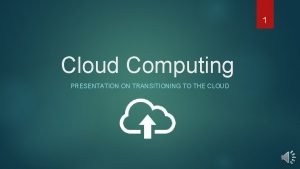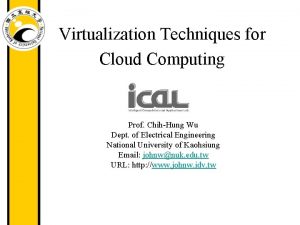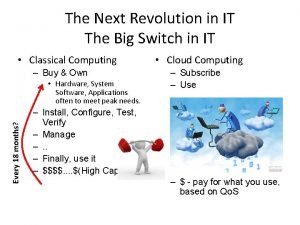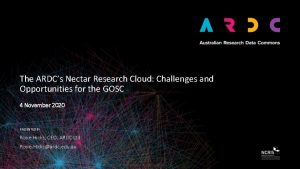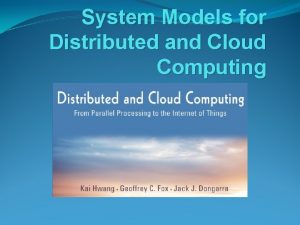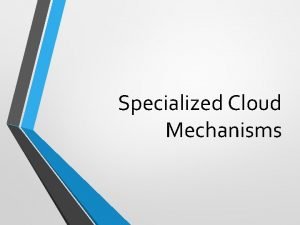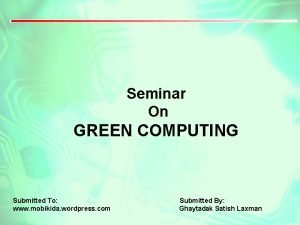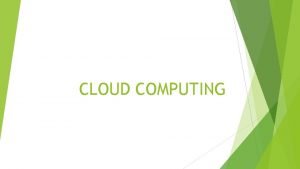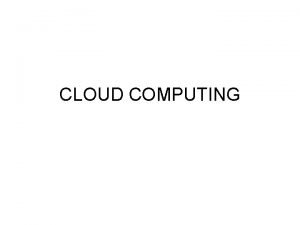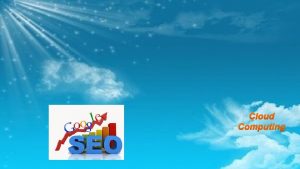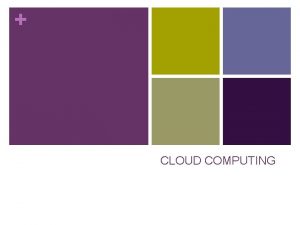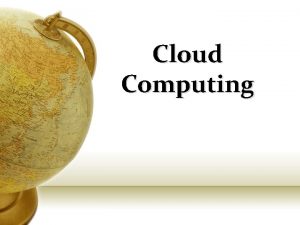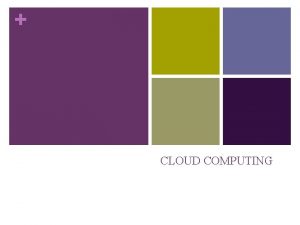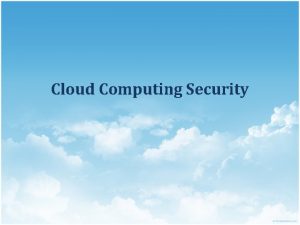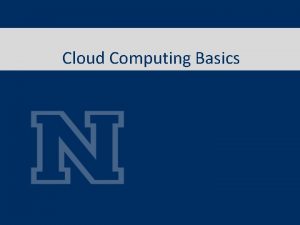1 Cloud Computing PRESENTATION ON TRANSITIONING TO THE











- Slides: 11

1 Cloud Computing PRESENTATION ON TRANSITIONING TO THE CLOUD

Table of contents: 1. What is the Cloud? 2. Cloud Computing Service Models. - Software as a Service (Saa. S). - Platform as a Service (Paa. S). - Infrastructure as a Service (Iaa. S). 3. Benefits of Cloud Computing. 4. Challenges Related to Cloud Computing. 5. Recommendations to mitigate security threats. 6. Conclusion 2

What is the cloud? It’s that thing in the sky, right? The cloud or cloud service, provides users software and other useful applications over the internet, instead of using traditional software installed on a device. The cloud can also provide user’s with storage options based on additional needs. A cloud service can be free or pay service based on organizational needs. These on-demand services can provide applications and data storage options without physically involving human interaction. With the cloud, you can access your information anywhere, anytime, provided that you have a connection to the Internet. 3

Service Models: Software as a Service (Saa. S): The more common cloud service that user’s have and are exposed too. Saa. S public providers include: Gmail, Dropbox, Microsoft One. Drive, Google Docs, etc. These services can be accessed on any compatible device and are always available to the user, provided they have internet access. User’s do not have to control any of the infrastructure or maintenance of provided Saa. S. 4

Service Models Cont: Platform as a Service (Paa. S): Used primary for software development. User’s can create applications using the providers software to deploy the project to other user’s Some examples of (Paa. S) include, Microsoft Azure, Google App Engine and Sales Force. The user does not have to provide server maintenance or resources to keep the service running. The user is only responsible for the application creation and deployment. 5

Service Models Cont: Infrastructure as a Service (Iaa. S): Provides computing solutions to organizations based on specific needs of the company. User’s have control over the operating system, storage, applications and networking. Examples of (Iaa. S) include, Amazon Web Services (AWS), Google Compute Engine and IBM Cloud Computing. Is a useful option to reduce resources spent on IT needs, such as an onsite data center, server maintenance, construction and energy consumption. 6

Benefits of Cloud Computing: The benefits of a cloud provider Reduced IT Costs: Cost of upgrades, hardware, software and overall maintenance is now included with your cloud provider. Scalability: Any organization can now scale in either direction depending on needs of the company. Business Continuity: Depending on a natural disaster, power outage or other threat, data is backed up to other locations and they can continue business as usual. Mobility: Allows employees to work freely anywhere, from the location of the office or work at home. 7

Challenges to Cloud Computing: The Challenges associated to cloud computing Security/Data Breaches: Ensuring that the cloud provider has the mitigation of security threats is always important. Reliability: Ensuring that data can always be accessed and that service is not interrupted. Data Privacy/Unauthorized Access: Data privacy is one of the major challenges with cloud computing. Data Destruction: Organizations may want to have data destroyed once a contract completes with a cloud provider. 8

Recommendations to mitigate security threats: How to secure the cloud Use end-to-end encryption: By using an end-to-end encryption method, it allows the data that is being stored to be totally encrypted. Researching Providers: Checking with the provider on security solutions and how they mitigate threats can help protect client and company data in the future. Single Sign-On Solution (SSO): Using a single sign-on solution prevents users having to write down multiple passwords and accounts. This allows one user to sign on with only having to remember one credential. 9

Conclusion: Wrapping it up! Why the cloud? : This presentation is to provide the necessary information to organizations who are thinking about transitioning to the cloud. Challenges: Organizations must pick the right model that will provide them with the necessary solutions for it’s corporate needs. Overall: Overall the cloud can serve as the primary infrastructure to an organization, to allow it’s employees to work more freely and have the added benefit of overall IT cost reduction. 10

Sources: Employment, S. B. (2018, April 20). Benefits of cloud computing. Retrieved from https: //www. business. qld. gov. au/running-business/it/cloudcomputing/benefits Top Five Challenges Of Cloud Computing. (n. d. ). Retrieved from https: //cloudtweaks. com/2012/08/top-five-challenges-of-cloud-computing/ 6 Major Challenges of Cloud Computing. (n. d. ). Retrieved from https: //www. techwell. com/techwell-insights/2017/10/6 -major-challengescloud-computing 5 Ways to Mitigate Cloud Computing Risks - Smart Buyer. (2016, November 03). Retrieved from https: //www. neweggbusiness. com/smartbuyer/over-easy/5 -ways-mitigatecloud-computing-risks/ 11
 Computing refers to
Computing refers to Internet and cloud computing presentation
Internet and cloud computing presentation Conventional computing and intelligent computing
Conventional computing and intelligent computing Vodafone cloud computing
Vodafone cloud computing Full virtualization in cloud computing
Full virtualization in cloud computing Virtualization
Virtualization Altostratus definition
Altostratus definition Cloud computing reference model
Cloud computing reference model Nectar cloud computing
Nectar cloud computing Explain system models for distributed and cloud computing
Explain system models for distributed and cloud computing Specialized cloud mechanisms
Specialized cloud mechanisms Green computing seminar
Green computing seminar

